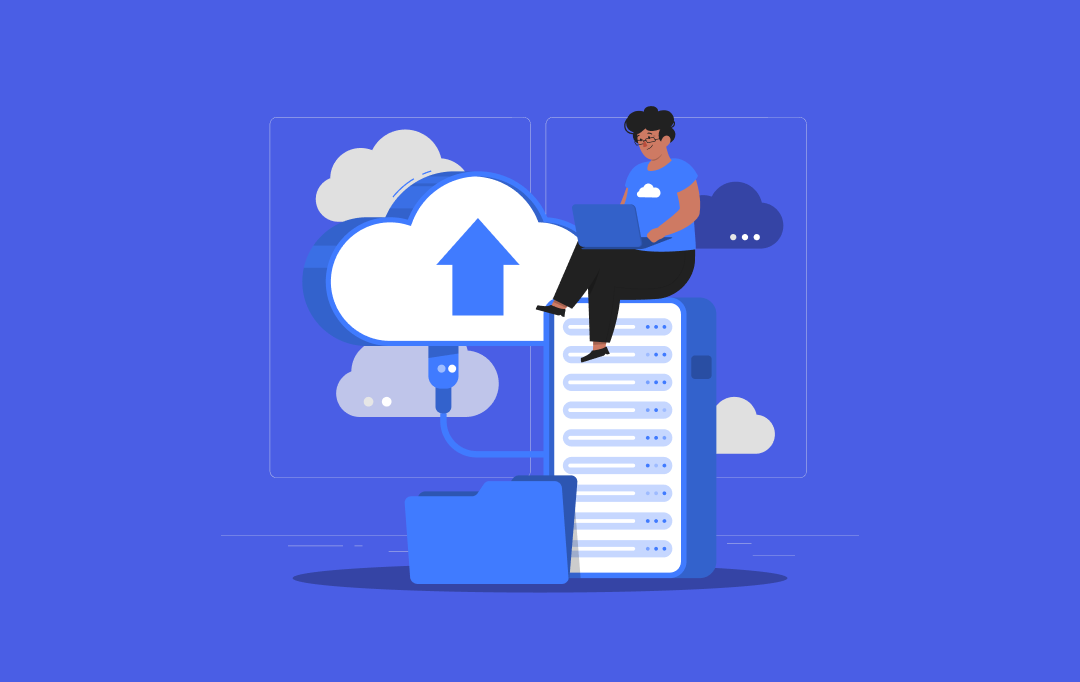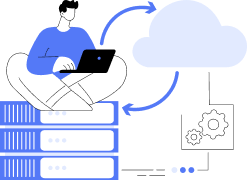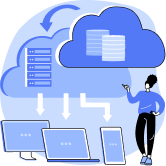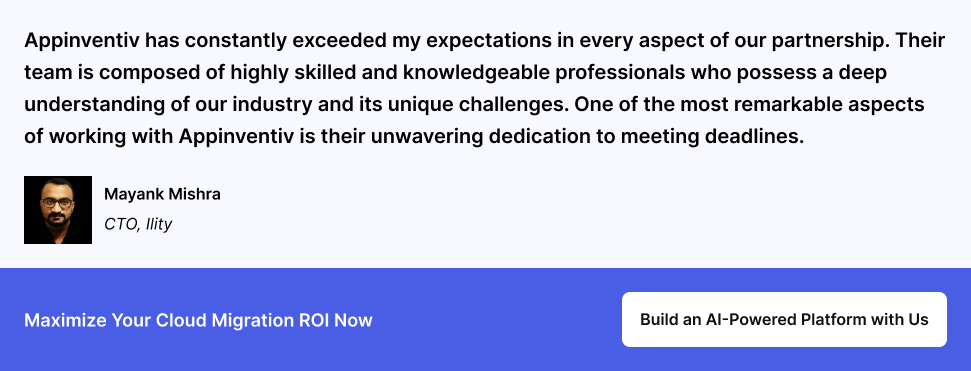- Understanding Cloud Migration ROI: The Calculation Formula
- Decoding Your Cloud Bill: What Are the Cloud Migration Cost Drivers
- The Upfront Handshake: Initial Setup Costs
- The Monthly Rent: Ongoing Operational Costs
- The Unseen Investments: The Hidden Costs
- The Other Side of the Coin: Measuring the True Benefits of Cloud Migration
- Cost Savings That Go Beyond the Obvious
- Operational Efficiency and Speed
- Enhanced Innovation
- Scalability for Growth Without Guesswork
- Improved Collaboration and Mobility
- Enhanced Security and Compliance
- Evaluating the ROI of Cloud Migration: A Step-by-Step Process
- Step 1: Define Your "Before" Picture (The Baseline)
- Step 2: Forecast Your "After" Picture (The Cloud)
- Step 3: Run the Numbers and Build the Analysis
- Step 4: Present Your Findings and Build the Business Case
- Post-Migration: Tracking and Optimizing ROI
- Your Toolkit for Assessing Cloud Migration ROI
- What Are Common Mistakes in Cloud ROI Evaluation & How to Avoid Them
- Maximize Your Cloud Migration ROI with Appinventiv
- FAQs
- A proper cloud migration cost estimation must factor in hidden expenses like employee retraining, potential downtime, and integration challenges.
- Faster time-to-market, boosted innovation with AI/ML tools, and improved business agility become critical pieces of your cloud migration cost-benefit analysis.
- Assessing cloud migration ROI means setting a clear baseline of your current costs and constantly tracking performance and spending.
- A solid cloud migration strategy, whether simple “lift-and-shift” or more complex “refactoring,” becomes absolutely key to positive cloud migration return on investment.
Let’s be real: moving your business to the cloud isn’t like flipping a switch. It is more like relocating your entire company to a new, hyper-modern city. Sure, the opportunities are dazzling: sleek infrastructure, fortress-like security, endless room to grow, etc. But you’d never sign the lease without a foolproof budget and a crystal-clear picture of what you’re getting into.
Yet, so many businesses jump into a cloud migration with their eyes closed, focusing on the technology without rigorously evaluating the ROI of cloud migration. They get swept up in the promise of operational utopia and forget to ask the tough financial questions. This almost always leads to sticker shock when the first cloud bills roll in, leaving executives scratching their heads and wondering where the promised savings vanished.
This difficulty arises because organizations must balance immediate expenses with the long-term strategic advantages that cloud adoption brings. It’s easy to focus on short-term costs, but the real value often lies in the long-term gains, like increased scalability, flexibility, and agility, which aren’t always immediately measurable.
Take Netflix as a perfect example. When they decided to move everything to AWS, the initial costs were substantial. But their smart approach to analyzing cloud migration cost benefit helped them grow from 23 million subscribers in 2011 to more than 260 million worldwide today. What made the difference?
They didn’t just look at infrastructure savings; they tracked innovation speed, global reach capabilities, and market positioning as essential ROI factors. This broader view of what constitutes “value” beyond the initial investment played a critical role in their success.
The real question isn’t if you should move, but how you can make the move pay off. A proper cloud migration ROI analysis is your map for this journey, helping you shift from a cost-focused mindset to a value-driven one. By looking at both hard savings and strategic advantages, you can ensure that the move to the cloud is more than just an expense; it’s an investment in future growth.
Contact us for a tailored cloud migration strategy that delivers real business value.
Understanding Cloud Migration ROI: The Calculation Formula
At its core, the formula for calculating the ROI of your cloud migration from legacy systems is surprisingly simple. It’s the same one you’d use for any business investment:
ROI = (Total Benefits – Total Costs) / Total Costs × 100
For instance, if the benefits are $190,000 and the costs are $100,000, the ROI would be 90%: ($190,000 – $100,000) / $100,000 = 90%.
Looks easy, right? The devil is in the details, specifically, in pinning down what those variables actually mean for a cloud project.
- Cost of Investment: This is way more than your monthly Azure or AWS bill. It’s the sum of every single expense, both upfront and ongoing, that comes with the migration.
- Net Gain from Investment: This is where the magic happens. It’s a mix of direct cost savings (the “hard” benefits) and the financial value of new efficiencies and business opportunities (the “soft” benefits).
Projected Financial Benefits to Evaluate During ROI Assessment
| Benefit | Expected Financial Impact |
|---|---|
| Reduced Operational Cost | 20% – 60% Savings |
| Accelerated Innovation | 10% Increased Revenue Per Year |
| Increased Scalability | 30% Savings During Peaks |
| Improved Data Insights | 10% – 20% Revenue Increase |
| Workforce Optimization | 20% – 30% Productivity Gain |
Getting these numbers right is the entire ballgame. A fuzzy cloud migration cost estimation at the start can sink your project before it even sets sail.
Also Read: Cloud Data Migration Strategy and Best Practices
Decoding Your Cloud Bill: What Are the Cloud Migration Cost Drivers
Before you can see a return, you have to truly understand the investment. One of the most common traps is underestimating the total cost of ownership (TCO). The real cloud migration cost drivers extend far beyond the flashy price lists on a provider’s website. A complete cloud migration cost analysis breaks them down into three buckets.
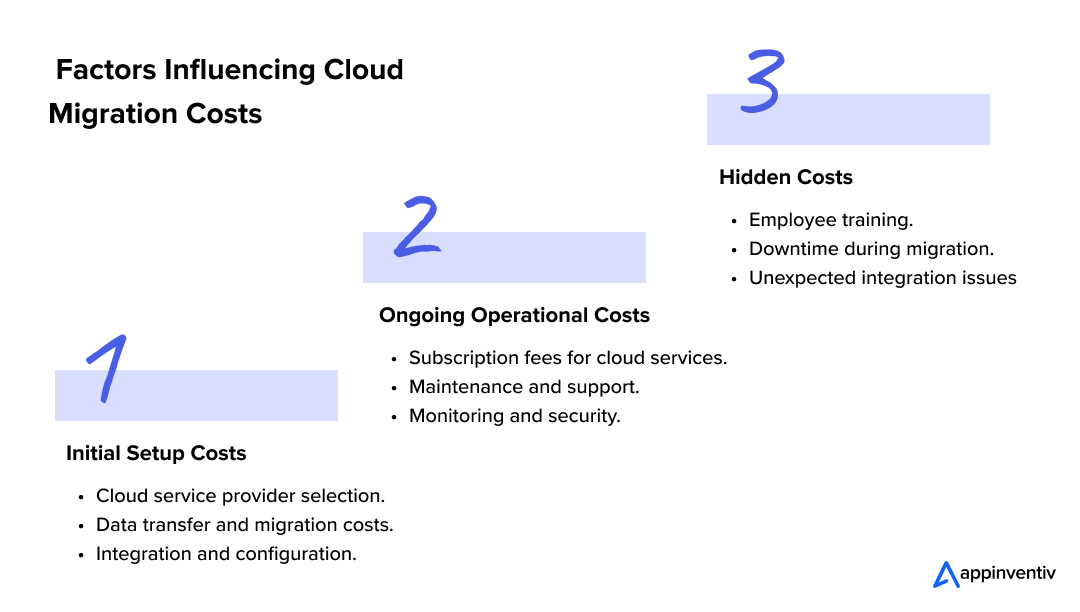
The Upfront Handshake: Initial Setup Costs
This is the price of admission. These are the one-time costs you’ll incur to get your operations out of your server room and onto the cloud. Here are the key cost drivers of this initial phase:
- Planning & Strategy: The initial research, analysis, and roadmap development isn’t free, especially if you partner with a cloud consulting company to help you figure out the best path forward.
- The Big Move (Data Migration): Moving terabytes of data costs money. The price tag depends on how much data you have, how you move it (over the wire vs. physical drives like AWS Snowball), and the manpower it takes.
- Renovations (Integration & Refactoring): Your apps might not work perfectly in the cloud right out of the box. Costs here can range from minor tweaks for a simple “lift-and-shift” to a full-blown architectural overhaul (“refactoring”) to get that sweet, cloud-native performance. This is a massive variable in any cloud migration cost estimation.
The Monthly Rent: Ongoing Operational Costs
This is what most enterprises picture when they think of cloud costs. These are the bills that will hit your inbox every month.
- Subscriptions: This is the core of your bill. Thai includes charges for virtual machines, storage, databases, and networking. This is usually based on what you use.
- Maintenance & Support: While the provider handles the hardware, you’re still on the hook for managing your software. You might also pay for premium support plans to get help faster when issues arise or systems malfunction.
- Tools & Security: You’ll need tools (either from the cloud platforms or a third-party cloud service company) to monitor performance, secure your data, and stay compliant. These all have their own price tags.
The Unseen Investments: The Hidden Costs
These are the costs that blindside unprepared businesses and torpedo an otherwise positive cloud migration ROI. Like an iceberg, the most dangerous part is what you don’t see.
- The Learning Curve (Employee Training): Your team needs to learn how to operate in a new environment. This means training on new tools, security protocols, and financial governance (FinOps) to control spending.
- Going Dark (Downtime): A poorly planned migration can lead to service interruptions, which translates directly to lost revenue and damaged customer trust.
- Square Pegs, Round Holes (Integration Issues): Legacy systems often don’t play nicely with modern cloud technologies. If your legacy applications need major modifications or reconfigurations to integrate with cloud environments, this can lead to unexpected costs and delays.
- The Forgotten Tab (Cloud Sprawl): Without tight controls, it’s frighteningly easy for teams to spin up resources and forget to turn them off, letting costs spiral out of control. This phenomenon, known as cloud sprawl, can result in unnecessary expenses, with businesses often spending 30% more on cloud services than necessary.
The Other Side of the Coin: Measuring the True Benefits of Cloud Migration
Focusing only on cutting costs is the fastest way to miss the whole point of the cloud migration cost benefit equation. The most powerful gains are almost always strategic. As McKinsey points out, companies that nail their cloud transformations can unlock immense value, projecting “more than $1 trillion in run-rate EBITDA” across Fortune 500 companies by 2030.
That kind of value comes from a lot more than just unplugging a few servers. In fact, many companies often find that the benefits of cloud migration far outweigh the initial or ongoing expenses when measured over time.
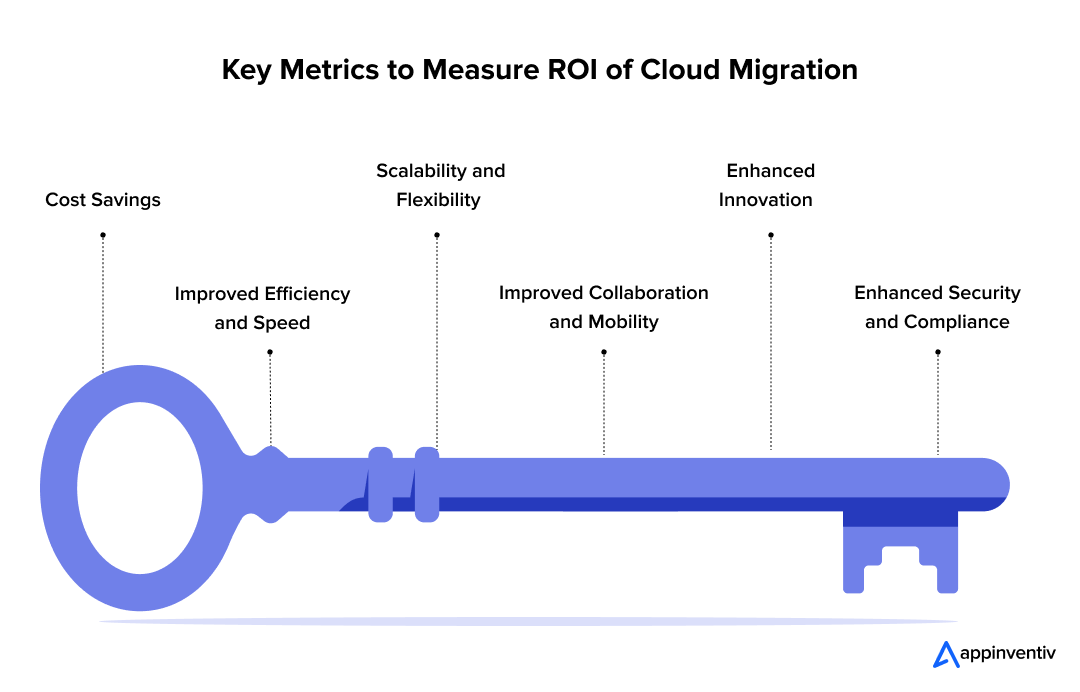
Cost Savings That Go Beyond the Obvious
Most companies talk about cost savings when they shift to the cloud, but it’s not just about cutting the cloud bill. You overlook the heavy costs of keeping on-premise hardware running, including server management, cooling systems, and staffing for system monitoring and maintenance. Cloud subscription fees usually cover these expenses, giving more predictable pricing.
The real win shows up in how you can scale. Instead of buying hardware big enough for your busiest day of the year and letting it sit idle the rest of the time, you scale up or down as needed. You pay for what you actually use; no more dead capacity sitting around eating budget. Companies that optimize this well often report trimming IT spend by 20% to 40% after migrating.
Operational Efficiency and Speed
Moving to the cloud changes how fast a company can move. Processes that once took hours – backups, patching, provisioning new servers – start happening in the background automatically. That means fewer late nights for your IT team and less downtime for everyone else.
Speed is the other big gain. Launching a new app or rolling out a feature can drop from months to hours because you’re no longer waiting for hardware to show up and get configured. In industries such as e-commerce or media streaming, where speed to market is paramount, this agility distinguishes market leaders from followers.
Enhanced Innovation
One of the least talked about but most powerful parts of cloud migration is how it opens doors to advanced tools. AI, machine learning, big data analytics, IoT: all of these are suddenly within reach without you building your own high-powered infrastructure.
Netflix and Spotify are classic examples: they rely on the cloud to analyze user behavior in real time and push out better recommendations and experiences. Doing that without the cloud would be technically possible, but painfully expensive and slow. Cloud platforms like Google Cloud or Microsoft Azure make it easy to try, test, and scale new ideas fast; it is a huge advantage in markets that change overnight.
Scalability for Growth Without Guesswork
Scaling used to mean guessing how big you might get and buying hardware in advance, which are often wrong and expensive guesses. With the cloud, growth becomes fluid. Seasonal rushes, big promotions, and product launches; cloud lets you expand resources immediately without breaking anything.
Airbnb’s surge periods are a good example: huge booking spikes during holidays or major events are handled with cloud elasticity, so the platform stays fast without paying for peak capacity year-round.
Improved Collaboration and Mobility
Today’s teams rarely sit in one place. Cloud-based tools like Google Workspace, Microsoft 365, and Slack let your employees work on the same document, chat in real time, and move projects forward even if they’re spread across time zones.
For employees, that flexibility matters; being able to work from home, a coffee shop, or while traveling makes work life smoother and helps companies keep talent longer. For the business, it means fewer bottlenecks and faster decision-making.
Enhanced Security and Compliance
Security is often the biggest hesitation before a cloud move, but modern providers are ahead of the curve. They bring layered protections: encryption, multi-factor authentication, and continuous monitoring, that most single companies can’t match on their own.
Another bonus: staying compliant with ever-changing regulations like GDPR, HIPAA, and PCI-DSS becomes less of a daily battle because the major players update their systems constantly to meet global standards. That lowers risk and avoids the kind of data breach disasters that can wreck both reputation and finances.
Based on the above-mentioned benefits, here is a brief table outlining the short-term and long-term benefits of cloud migration:
| Short-term benefits | Long-term benefits |
|---|---|
| Improved scalability | Reduced TCO |
| Higher product availability | Increased staff productivity |
| Stronger security | Faster disaster recovery |
| Greater system stability | Higher innovation potential |
| Faster software engineering | Strategic advantage over competition |
Evaluating the ROI of Cloud Migration: A Step-by-Step Process
Ready to get your hands dirty? Evaluating the ROI of cloud migration is a step-by-step process. Follow this playbook to move from vague ideas to a decision backed by hard data.
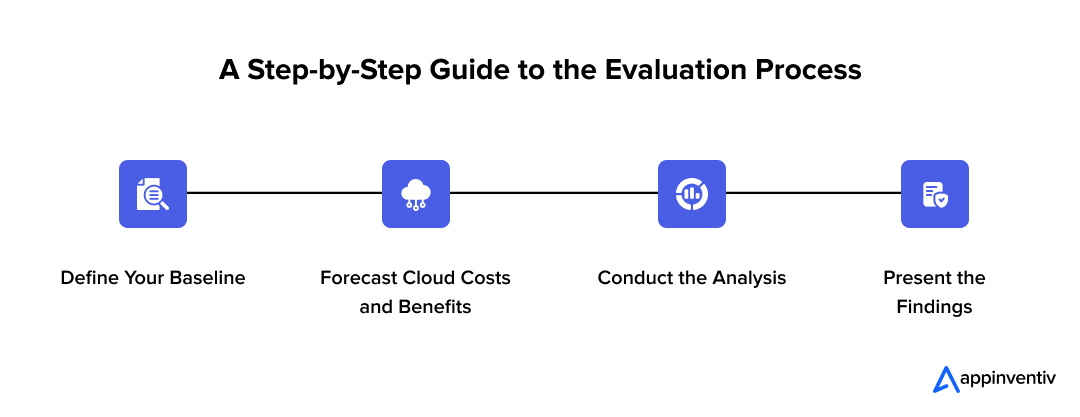
Step 1: Define Your “Before” Picture (The Baseline)
You can’t know if the new city is better if you don’t know what your old town was like. It simply means that before you even glance at a cloud provider’s price, you must deep dive into your current on-premise setup.
Document everything:
- Hardware: Server purchase prices, maintenance contracts, and how often you replace them.
- Software: Licensing fees for everything from operating systems to databases.
- Facilities: Power, cooling, and data center rent.
- Resources: The salaries of IT staff who spend their days maintaining infrastructure.
- Performance: How often are your apps down? How long does it take to deploy a new feature?
This baseline is the foundation of your entire cloud migration cost analysis.
Step 2: Forecast Your “After” Picture (The Cloud)
Now, project your future state. This involves more than just plugging numbers into a provider’s calculator, which can often be overly optimistic.
- Estimate Cloud Costs Realistically: Work with a solutions architect to model what you’ll actually use. Don’t forget to account for data transfer fees, premium support, and monitoring tools. This detailed projection is crucial for a reliable cloud migration cost estimation.
- Put a Price on the Priceless: This is where you get creative. Sit down with your business leaders. If the marketing team can launch campaigns 20% faster, what’s the revenue impact? If the R&D team can run ten times more experiments with cloud AI, what’s that innovation worth? Converting these qualitative benefits into dollars is the secret to a powerful cloud migration cost benefit case.
Step 3: Run the Numbers and Build the Analysis
With your “before” and “after” data ready, it’s now time to do the math and perform the analysis.
- Calculate the ROI: Use the formula from earlier. Project it over three to five years to show the long-term payoff.
- Find the Payback Point: Figure out how many months it will take for your savings and gains to cover the initial migration cost. A shorter cloud migration payback period is always more attractive to financial stakeholders.
- Create a Comparison Chart: A clear table comparing on-premise vs. cloud costs and benefits side-by-side is incredibly effective. Include both quantitative financial figures and qualitative strategic advantages.
Step 4: Present Your Findings and Build the Business Case
You’ve done the core part; now it’s time to sell the vision.
- Tell a Story with Your Data: Don’t just present a spreadsheet on the table. Use charts to visualize the savings, the cloud migration return on investment, and the payback timeline.
- Know Your Audience: Tailor your pitch. The CFO wants to hear about TCO and ROI. The CTO is focused on security and scalability. The Head of Product cares about speed-to-market.
- Acknowledge the Risks: Acknowledge potential cloud migration challenges and ROI risks, like cost overruns or security concerns, and present a clear mitigation plan. This builds credibility and shows you’ve done your homework.
Also Read: Unleashing the Potential of Cloud in Digital Transformation
Post-Migration: Tracking and Optimizing ROI
Cloud migration isn’t “set and forget.” To maximize ROI, you must:
- Monitor actual cloud spend vs. forecast. You can also use cloud dashboards for real-time insights.
- Identify unused resources, right-size workloads, and automate scaling.
- Regularly assess business metrics (deployment speed, downtime, customer satisfaction).
- Adjust Strategy: Use findings to tweak your cloud architecture and cost controls.
Best Practice: Set quarterly ROI reviews post-migration to ensure you’re meeting targets and to catch cost overruns early.
Your Toolkit for Assessing Cloud Migration ROI
Cloud migration costs and ROI evaluation are complex processes, but the good news is that you are not alone in this journey. There are plenty of tools and resources available that can help you perform a much more accurate cloud migration cost and benefit analysis. For the cloud migration cost, you can refer to our detailed blog, and for the ROI evaluation, please stick to the below-listed strategies:
Cloud ROI Calculators: The big three cloud providers (AWS, Azure, and GCP) have tools that are a great place to start:
- AWS Pricing Calculator & TCO Calculator
- Azure Pricing Calculator & TCO Calculator
- Google Cloud Pricing Calculator
Just remember, while these are the popular cost calculators, they are marketing tools. They’re useful for a first pass, but they won’t catch all the hidden costs or strategic benefits unique to your business.
Expert Guidance: This is how you can truly refine your numbers. Working with an experienced Cloud Migration Services provider or a cloud consulting company helps you define your goals and gives an expert opinion. They’ve seen it all before and can spot problems and opportunities you’d likely miss. Their insights are gold when it comes to accurately calculating the ROI of your cloud migration.
Learn from Others: See what similar companies in your industry have done and what they have achieved. While you can’t just copy-paste their outcomes, their case studies and industry benchmarks can provide a realistic sanity check for your projections and help you build a more credible business case.
Cloud migration isn’t just about cost-saving; it’s about future-proofing your business. Discover the best ROI strategies with our experts.
What Are Common Mistakes in Cloud ROI Evaluation & How to Avoid Them
Even with the best plan, it’s easy to stumble when evaluating the ROI of cloud migration. This can lead to budget overruns, timeline delays, and disappointing outcomes. Understanding these common pitfalls enables better preparation and risk mitigation strategies. Let’s uncover the common blunders:
| Mistake | Description | Impact on Cloud Migration ROI |
|---|---|---|
| Ignoring the Hidden Costs | Forgetting to budget for training, refactoring, and the inevitable productivity dip during the switch. This is the number one mistake businesses make when migrating. | These unplanned expenses can lead to cost overruns, significantly affecting ROI. |
| Just Lifting and Shifting | Simply moving your servers to the cloud as-is (a “lift-and-shift”) without taking advantage of cloud-native features. | It leads to low ROI, as it doesn’t unlock the full potential of cloud advantages. |
| Losing Sight of the “Why” | If your Cloud Migration Strategy isn’t tied to a real business goal (such as entering a new market or speeding up product launches), you’re not addressing real pain points. | This leads to wasted resources, moving problems to a more expensive location instead of solving them. |
| Forgetting the Cops | Failing to set up cost management controls from day one is like handing out unlimited company credit cards. | Without controls, costs spiral out of control, ruining the projected ROI and leading to financial surprises. |
Maximize Your Cloud Migration ROI with Appinventiv
Figuring out the ROI of a cloud move isn’t just about crunching numbers; it’s about making a smart, strategic decision for your company’s future. As we’ve covered, the real win from the cloud isn’t just saving a few dollars on servers. It’s about becoming faster, more innovative, and more resilient. But how can you turn that potential into actual, tangible results? That takes a trusted cloud partner who has proven experience in doing that right and yielding impressive outcomes.
This is where we come in. In our 10+ years of experience, we have partnered with many leading brands and stood by them in their cloud migration journey, which resulted in lucrative ROI in the long run.
Here’s a Glimpse of Our Partnerships in Action:
- Y.K. Almoayyed & Sons: We helped this leading retail and distribution company modernize its operations by implementing scalable cloud solutions.
The result? Streamlined operations, Better data visibility, and a 32% reduction in IT costs. Thai proves the long-term value of cloud migration.
- Avatus: For this secure avatar-based social networking platform, we designed a cloud-first architecture that enabled real-time scalability and ensured user data privacy.
The result? A secure and scalable platform that meets the demands of a growing user base while maintaining stringent data security standards.
- TrackMyShuttle: Our team developed a cloud-powered shuttle management app that allows commuters to track rides in real time and improve ride coordination.
The result? Reduced operational barriers and improved reliability for both riders and operators. This demonstrates how cloud computing can transform everyday services.
- Ility: Appinventiv built Ility, a white-label SaaS platform for real estate management. The cloud-powered solution optimized property portfolios, automated key processes, and reduced operational costs for property managers.
The result? 2% increased landlord ROI, 40% higher occupancy, enhanced operational efficiency, reduced infrastructure costs, and enriched customer satisfaction
Our team of 1600+ tech experts has helped businesses of all sizes create tailored cloud strategies that are fully compliant with industry regulations because we understand the main challenge is not just the migration, it is the ROI and security.
So, if you’re ready to build a business case for the cloud that gets a clear “yes,” and a “big win”, we are here to help. Maximize your cloud ROI with a leading cloud consulting company like Appinventiv.
FAQs
Q. What benefits besides cost savings does cloud migration provide?
A. Cloud migration delivers non-cost perks, such as:
- Scalability: Dial resources up or down based on demand
- Flexibility and Agility: Launch fresh products and services quickly
- Improved Security: Cloud providers bring tough security protocols
- Disaster Recovery: More reliable and faster recovery times
- Faster Time to Market: Deploy new apps and services faster
Q. What are the hidden costs of migrating to the cloud?
A. Hidden expenses of cloud migration are:
- Training: Employees may need extra training to run cloud services
- Data Transfer: Moving massive data volumes into the cloud gets expensive
- Integration Costs: Merging legacy systems with cloud services racks up extra bills
- Ongoing Management: Surprise costs of maintaining and optimizing cloud infrastructure
Q. How to compare on-premises vs cloud ROI?
A. Comparing on-premises versus cloud ROI strategy includes:
- On-premises costs: Upfront hardware purchases, data center maintenance, utilities, and long-term operational expenses.
- Cloud costs: Subscription fees, usage-based expenses, and potential cost swings based on cloud provider.
- Key factors: Consider scalability, performance, flexibility, and long-term costs rather than just short-term bills.
Q. What are the cloud migration cost drivers?
A. The cost drivers for cloud migration include:
- Data transfer and storage: Transferring large datasets and choosing the appropriate storage type.
- Migration tools: Licenses and fees for third-party tools used during migration.
- Application reengineering: Refactoring apps to be cloud-compatible.
- Consultation: Costs for expert consultation and cloud service providers’ support.
Q. How to estimate cloud migration TCO (Total Cost of Ownership)?
A. Estimating cloud migration TCO means both direct and indirect costs over the migration lifecycle:
- Initial costs: Migration fees, training, tools, consultant charges
- Ongoing costs: Monthly cloud services, storage, and monitoring fees
- Hidden costs: Old system integration, downtime, unexpected expenses
Q. How to assess cloud readiness before migration?
A. Before migrating, check:
- Infrastructure: Current systems can integrate with cloud environments
- Skills and knowledge: Your team is ready for transition
- Business needs: Cloud services match business objectives
- Data security and compliance: Compliance with regulations and security standards
Q. What strategies maximize cloud migration ROI?
A. Here are some tried and tested strategies to maximize cloud migration ROI:
- Regularly monitor cloud cost and optimize resource usage
- Use cloud automation
- Leverage multi-cloud strategy
- Refactor apps for better cloud compatibility
Q. How to calculate ROI for cloud migration?
A. Cloud migration ROI is calculated by:
- Subtracting costs: Deduct all migration and operational costs.
- Calculating benefits: Include savings, efficiency gains, and revenue growth.
- ROI Formula: ROI = Total Benefits−Total CostsTotal Costs × 100
Q. How to estimate cloud migration cost?
A. You can estimate cloud migration cost by keeping in account the hidden costs, upfront costs, and ongoing expenses.
Q. What qualitative benefits should be considered in cloud migration ROI?
A. Besides financial metrics, qualitative benefits:
- Better customer experience from faster, more reliable services
- Enhanced flexibility, ability to innovate
- Scalability to quickly adjust to market or business changes
- Better security from cloud providers’ tough infrastructure
Q. Which migration strategy (lift-shift, refactor, replatform) gives better ROI?
A. All strategies give better ROI in different scenarios:
- Lift and Shift: Fast migration, but may not optimize cloud potential for cost or performance
- Refactor: Best ROI long-term by redesigning apps for cloud benefits (automation, scalability), though pricier
- Replatform: Middle ground, improving app efficiency, cost without full reengineering
Q. What are common mistakes in cloud ROI evaluation?
A. The common mistakes include:
- Ignoring hidden costs like training, migration downtime
- Overestimating savings from the cloud without fully optimizing resources
- Underestimating long-term cloud costs (storage, scaling)
- Not accounting for potential performance drops during the transition period
Q. What are the Qualitative vs. Quantitative benefits of cloud migration?
A. Quantitative benefits are measurable, which mainly focus on cost and efficiency, while qualitative benefits highlight long-term advantages like innovation and improved customer experience.
Both are essential for evaluating cloud migration.


- In just 2 mins you will get a response
- Your idea is 100% protected by our Non Disclosure Agreement.
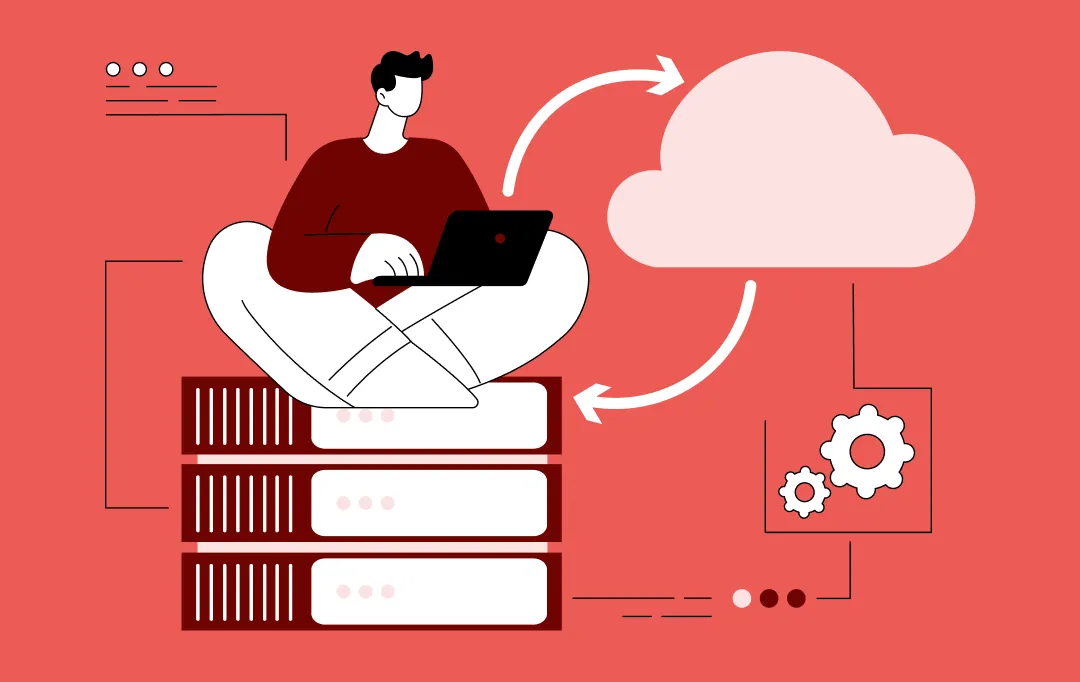
Green Cloud - How Cloud Adoption Helps Improve Sustainability/ESG Goals of Enterprises
Key takeaways: Adopting green cloud solutions lowers energy consumption, cuts emissions, and reduces operational costs. Companies like UEM Edgenta and Bharti Airtel have seen measurable improvements in sustainability and efficiency. AI Enhances Green Cloud Efficiency. AI optimizes energy use, predicts demand, and minimizes waste in cloud infrastructure. Your Green Cloud Roadmap. Start with an infrastructure…
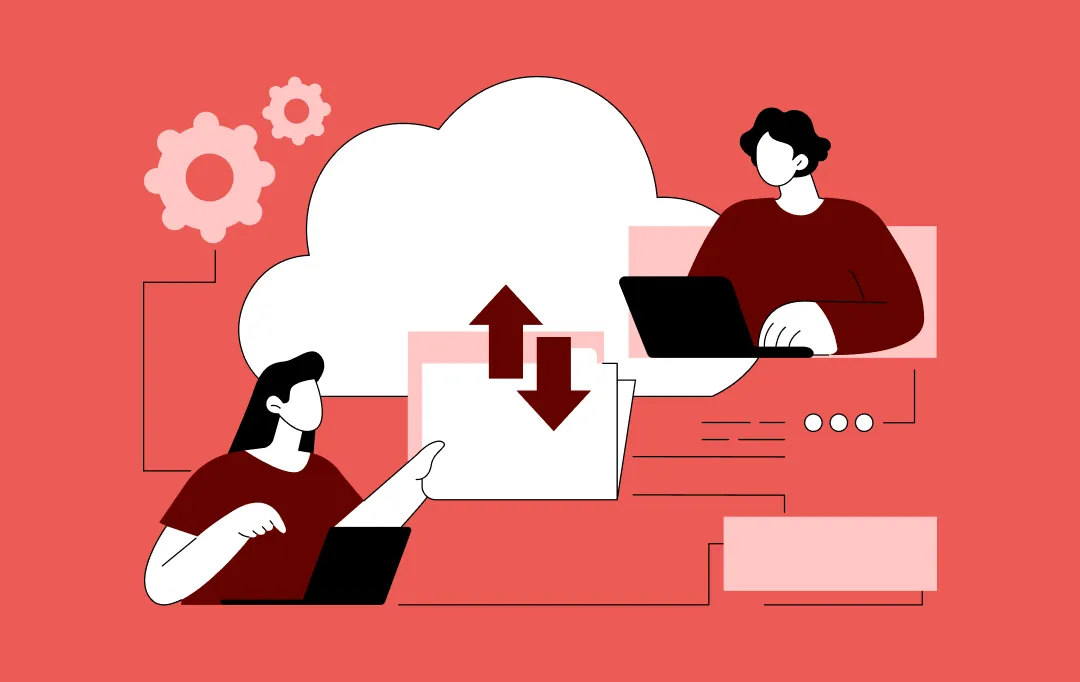
Cloud Migration Strategy for Enterprises in Australia: Benefits, Implementation Process and Tools
Key takeaways: Cloud migration in Australia is accelerating as enterprises modernize aging systems and prepare for AI-driven workloads. Local cloud regions in Sydney, Melbourne and Brisbane make compliance and performance far easier for large-scale migrations. A strong cloud migration strategy for enterprises in Australia depends on clear assessment, the right tools and ongoing optimization. Industry…
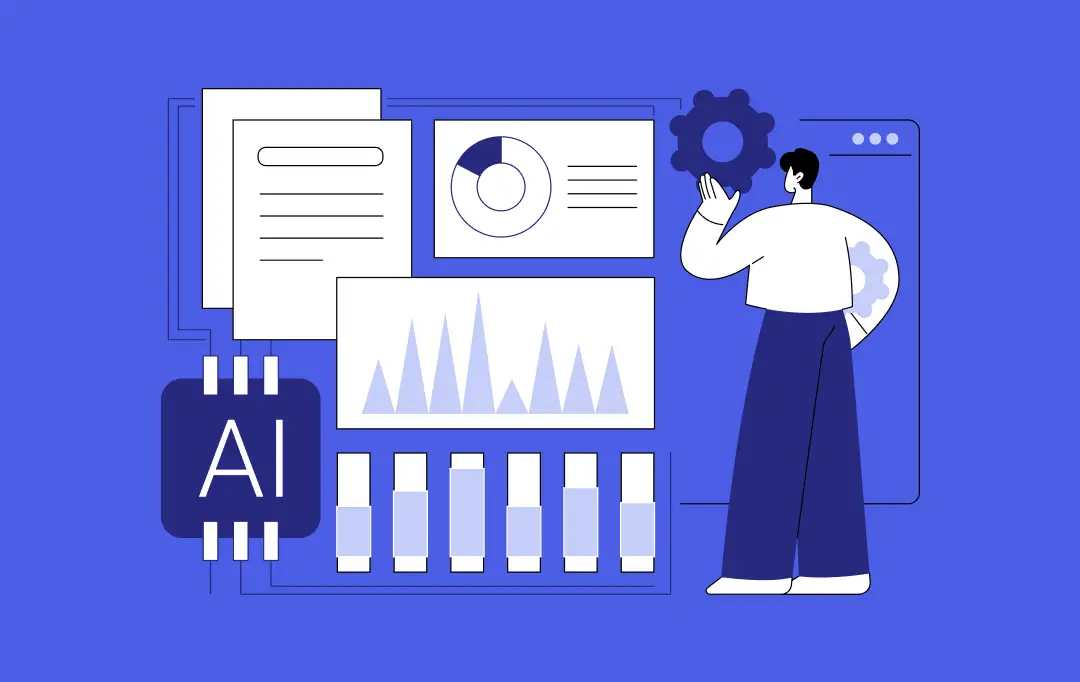
How to Ensure Data Integrity and Security During Cloud Migration?
Key takeaways: Learn how to assess risks during migration, ensuring data integrity and compliance with global standards like GDPR and HIPAA. Secure your cloud transition by implementing encryption, checksum verification, and real-time validation to maintain data accuracy. Address issues like legacy data models, schema mismatches, downtime, and third-party toolchain risks that could threaten data integrity.…


























